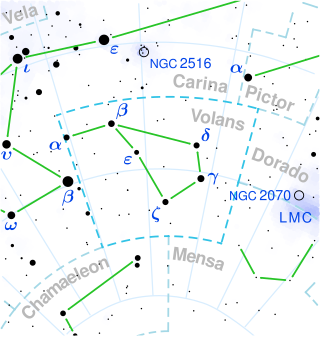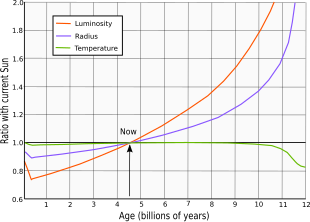
Scutum is a small constellation. Its name is Latin for shield, and it was originally named Scutum Sobiescianum by Johannes Hevelius in 1684. Located just south of the celestial equator, its four brightest stars form a narrow diamond shape. It is one of the 88 IAU designated constellations defined in 1922.

A proplyd, short for ionized protoplanetary disk, is an externally illuminated photoevaporating protoplanetary disk around a young star. Nearly 180 proplyds have been discovered in the Orion Nebula. Images of proplyds in other star-forming regions are rare, while Orion is the only region with a large known sample due to its relative proximity to Earth.
HD 63454, formally named Ceibo, is a star located in the southern circumpolar constellation Chamaeleon near the border with Mensa. To see the star, one needs a small telescope because it has an apparent magnitude of 9.36, which is below the limit for naked eye visibility. The object is located relatively close at a distance of 123 light years based on Gaia DR3 parallax measurements but is receding with a heliocentric radial velocity of 33.8 km/s. At its current distance, HD 63454's brightness is diminished by two tenths of a magnitude due to interstellar dust. It has an absolute magnitude of +6.68.

Omega Andromedae is the Bayer designation for a slowly co-rotating binary star system in the northern constellation of Andromeda. Parallax measurements made during the Gaia mission make this system to be approximately 93.9 light-years from Earth. Its apparent visual magnitude is +4.83, which makes it bright enough to be seen with the naked eye.
36 Ursae Majoris is a double star in the northern constellation of Ursa Major. With an apparent visual magnitude of 4.8, it can be seen with the naked eye in suitable dark skies. Based upon parallax measurements, this binary lies at a distance of 42 light-years from Earth.
HD 115337 is a binary star located in the northern circumpolar constellation Camelopardalis. The pair have a combined apparent magnitude of 6.25, placing it near the limit for naked eye visibility. Parallax measurements place the system at a distance of 698 light years. It has a heliocentric radial velocity of −9.4 km/s, indicating that it is drifting towards the Solar System.

Epsilon Chamaeleontis, Latinized from ε Chamaeleontis, is a triple star located in the southern circumpolar constellation Chamaeleon. The primary and secondary have apparent magnitudes of 5.33 and 6.02, making them visible to the naked eye. Hipparcos parallax measurements place the system at a distance of 360 light years and is currently receding with a heliocentric radial velocity of 13 km/s.

Kepler-56 is a red giant in constellation Cygnus roughly 3,030 light-years (930 pc) away with slightly more mass than the Sun.
HD 165185 is the Henry Draper Catalogue designation for a star in the southern zodiac constellation of Sagittarius. It has an apparent visual magnitude of 5.94, which indicates it is a sixth magnitude star that is faintly visible to the naked eye. Parallax measurements give an estimated distance of 55.8 light years from the Sun. It is drifting further away with a heliocentric radial velocity of +15.4 km/s.

HD 111395 is a single, variable star in the northern constellation of Coma Berenices. It has the variable star designation LW Com, short for LW Comae Berenices; HD 111395 is the Henry Draper Catalogue designation. The star has a yellow hue and is just bright enough to be barely visible to the naked eye with an apparent visual magnitude that fluctuates around 6.29. Based upon parallax measurements, it is located at a distance of 55.8 light years from the Sun. The star is drifting closer with a radial velocity of −8.9 km/s. It is a member of the Eta Chamaeleontis stellar kinematic group.

HV 888, also known as WOH S140, is a red supergiant (RSG) star located in the Large Magellanic Cloud. It is possibly among the largest known stars, with reliable estimates of its radius ranging from 1,353 R☉ to 1,584 R☉, and is also one of the most luminous of its type with a range of nearly 300,000 to over 500,000 times that of the Sun (L☉). The effective temperature is estimated to be around 3,500 K. If placed at the center of the Solar System, its photosphere would engulf the orbit of Jupiter.

HD 70514, also known as HR 3280, is a solitary, orange hued star located in the southern circumpolar constellation Volans, the flying fish. It has an apparent magnitude of 5.06, making it one of the brighter members of this generally faint constellation. Based on parallax measurements from the Gaia spacecraft, the star is estimated to be 298 light years distant. It appears that its distance to the Solar System isn't changing, having a heliocentric radial velocity of 0 km/s. Eggen (1994) lists it as a member of the thin disk population.
HD 193556 is a solitary star in the equatorial constellation Delphinus. It has an apparent magnitude of 6.17, making it visible to the naked eye under ideal conditions. Parallax measurements place the object at a distance of 467 light years and it is currently receding with a heliocentric radial velocity of 11.7 km/s.

19 Leonis Minoris is a spectroscopic binary located in the northern constellation Leo Minor. It has an apparent magnitude of 5.1, making it one of the brighter members of the constellation. The system is relatively close at a distance of 94 light years but is drifitng closer with a heliocentric radial velocity of 8.6 km/s.











